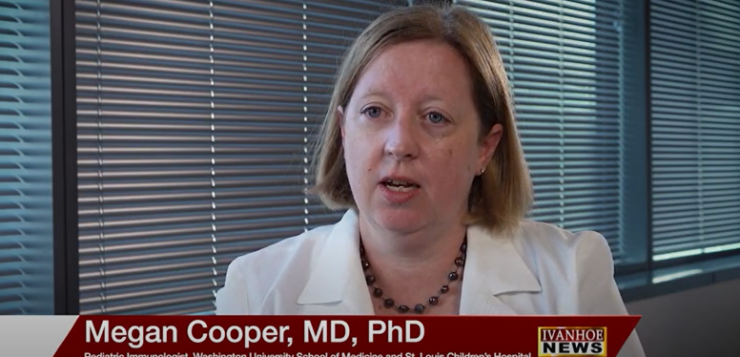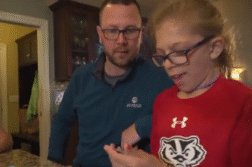Megan Cooper, MD, PhD, a pediatrician and pediatric immunologist at Washington University School of Medicine and St. Louis Children’s Hospital, talks about how researchers worldwide are working together to find innovative ways to help save kids from a rare disease.
What is INFLTR8?
COOPER: This is a disease that we discovered in boys where they have susceptibility to infection. And this is due to what we call a gain of function mutation in a gene called TLR8. So, this is a gene that encodes a protein that normally should sense when there’s an infection and should turn on and trigger an inflammatory response. But what we’re seeing in the boys is that they have inflammatory response turned on inappropriately. So, their body’s immune response is basically turning on without a trigger. This high inflammatory response that they have actually leads to a lowering of their immune cells because of all of inflammation that they have, making it harder to fight infections. In many other patients, this had led to bone marrow failure. This means that their bone marrow can’t make immune cells and red blood cells productively anymore. Ultimately, these patients have had to have bone marrow transplantation.
What’s the outcome of this? I mean, does your immune system just shut down then?
COOPER: So, you know, we’re really just starting to learn about this disease. We described the first six patients with INFLTR8 this past spring, and actually right after that publication other clinicians reached out to us, and we have identified another two patients since then. So, we’re really learning what this disease is and the symptoms it causes in patients. Unfortunately, we are learning that it’s a very serious disease. Two of the patients in our study passed away due to INFLTR8, and several other patients required bone marrow transplantation. We do think that bone marrow transplant has the potential to treat this disease. But what we’re really looking for next is how now that we know the molecular mechanism. We know that patients have gain of function in TLR8, but we need to figure out how this can be used to treat the patients.
What do they pass away from?
COOPER: Yes, so the patients that have died unfortunately have died from infection. And that’s because the bone marrow just can’t make enough immune cells to be able to fight off infection.
I mean, when you think about this, it’s a very rare disease. Do you think it’s very rare or just hasn’t been diagnosed?
COOPER: So, I think that it’s rare. I don’t think it’s as rare as we think it is right now. We now have a way to diagnose this, and we have a specific gene that we can look for, so we will now be able to identifymore patients with IFNFLTR8 that have gone overlooked.
The first patient that you came in contact was Joseph?
COOPER: No, it was actually a different patient that we had here at St. Louis Children’s Hospital. A teenager.
Is that Brandon?
COOPER: No, he was diagnosed more recently.
OK, Brandon was later.
COOPER: Yes. So the first patient that we identified with INFLTR8 was a patient that was referred up here to St. Louis Children’s Hospital with longstanding low immune cells, low neutrophils and some other signs and symptoms of inflammation that were confusing and hard to parse out. He was really just undiagnosed. It was by genetic sequencing that we were able to identify that patient.
How do you diagnose them? Is it through a blood test? Is it pretty simple to find out?
COOPER: So, it is a blood test but it’s not that simple. The one big complicating thing with this disease is that the genetic change is actually mosaic. This means that not every cell in the body has the genetic change that causes the disease, and sometimes it can be a very small amount of cells. For example, less than 10% of the cells can have this genetic change in the TLR8 gene, but this can still cause disease in patients. Being able to identify a small genetic change in10% of immune cells can be tough.
So, what do you think for you is the biggest mystery about this disease?
COOPER: So, I think the biggest mystery is, what is triggering it? Because we know that some kids have started to have the disease when they’re very young, as young as 1 years of age. But then other kids, for example like Evan, were affected when they become teenagers. A big question is what trigger causes the immune system to go awry, especially when they’ve potentially had this genetic change most of their lives?
So, do any present as newborns or does it come on and then they can’t fight infection and that’s how you find out?
COOPER: We have not seen any newborns, but we have seen a couple of patients present around age 1, and then we’ve seen them present as late as age 18.
Is there any rhyme or reason why it’s only boys?
COOPER: So, this genetic change affects a gene that’s located on the X chromosome. Boys only have one copy of the X chromosome, and so we think that’s why they’re more likely to have disease or at least that we recognize it. We do, however, think that girls can be affected because this is a gain of function. Meaning, there’s too much activity in the protein. So, we do think that if girls had the genetic change that they might be affected as well.
So, tell me a little bit about Joseph. He was able to help even though he wasn’t able to be saved?
COOPER: Joseph and his family were just wonderful, wonderful people. And I’m sorry I never got to meet him. We had talked about him flying here,but that was right at the start of COVID-19 and we didn’t want to take any risk of infection for him. But Joseph’s family was very gracious, and his physicians at his home hospital were fantastic collaborators. So, they were able to send samples from Joseph and what we were able to do is create cell lines. This means that we could take some of his immune cells and grow them in the lab, and in that way, we could study TLR8. Evan’s another great story. Can you tell me about Evan?
COOPER: Evan is a college student who had symptoms when he was a teenager. Because IFNLTR8 was not yet discovered, he unfortunately went undiagnosed for several years, which is what we’re seeing with these patients because they have this constellation of symptoms with low immune cells yet high levels of inflammation, fevers, and recurrent infections. Really until we were able to identify thatINFLTR8 was due to a genetic change in TLR8, they went undiagnosed. Evan had some fantastic doctors both at home and he also went to the NIH for additional testing. Once we started talking to other physicians about our findings with INFLTR8 and TLR8, his physicians realized that Evan might be one of those patients and reached out to us. Indeed, he was. And we were able to confirm that and use samples, blood samples from Evan. Even though he wasn’t able to travel here at the time due to COVID-19, we were able to get blood cells from him and a skin sample from him and able to identify what was going on.
He has, like, a special little story about the naming of this.
COOPER: Yes, he does.
Didn’t he want it to be Evan’s disease?
COOPER: So, you know, this is not the first time a patient has asked can they name the disease after themselves, which I think is fantastic. And it just really goes to show how much patients are interested in finding out what is wrong and really interested in research and wanting to know the answer to what’s been going on with them for so long. So, he had emailed me and asked if we could name it after him and I said well, that’s not really how it works. We can’t do that. But you know what? Let’s think if you can think about a catchy name. So, I told him some of the symptoms that other patients are having and he’s the one who came up with INFLTR8, which stands for “Inflammation, Neutropenia, bone marrow Failure, and Lymphoproliferation caused by TLR8”, and is a great nameand that’s what we’re calling it.
So, like, for Evan, so what was he, like, kind of, I hate to say this word, but misdiagnosed as? Like, what would be some of the other things that doctors think it is?
COOPER: He wasn’t misdiagnosed, because we didn’t know that this disease existed until recently. But what Evan was diagnosed with was a bone marrow disease and neutropenia. So, neutropenia means low neutrophil counts. These are really descriptive diagnoses, meaning that it describes their symptoms but not the cause. By being able to have a genetic diagnosis, we can put a name to to the disease and that genetic diagnosis will enable us to really target therapy and have earlier diagnosis.
I guess I shouldn’t be surprised, but I’m surprised in this day and age that there are still diseases out there that haven’t ever been found. But is it that rare?
COOPER: You know, so in my field just about every other week we’re discovering a new disease. The molecular age is really here, meaning that we can more readily diagnosis genetic causes for many disorders. I deal with rare problems of the immune system andwe work very hard to identify the cause of disease in these patients by doing genetic sequencing, and then taking a very close look at that sequencing data.
So, do you think COVID’s going to open up a whole new level of diseases that you’ll be involved in?
COOPER: Yes, so COVID already has actually, and I’ve been involved in a consortium of investigators, actually immunologists around the world. This consortium has actually identified several molecular defects that make individuals more susceptible to COVID.
So, on the idea, what’s the one thing you want people to know about COVID and you have a rare look into it?
COOPER: One thing I wish people knew about COVID. You know, COVID is really not, like, any infection that we’ve seen before. I think that’s what I would like people to know. So as a rheumatologist and immunologist, I see kids with MIS-C. MIS-C is a post-inflammatory reaction to COVID, and is really just like nothing I’ve seen in my career before. So, this is not the flu. This is not a bad cold. It’s really very different from anything that I’ve encountered, and get vaccinated, please. Having young children of my own, I’m very much looking forward to vaccination being available to children.
What’s next for this rare disease, not COVID?
COOPER: The next thing we really need to do in INFLTR8 is think about how we can actually target that TLR8 mutation that we identified in the patients. So, if we can give a very specific therapy to the patients to target their known molecular defect, we can potentially maybe even avoid the need for bone marrow transplantation.
Could you stop it? Reverse it? What would be that hope?
COOPER: The hope is that we can actually specifically stop the disease in the patients and have long-term therapy that can enable the patients to live a very full life.
Interview conducted by Ivanhoe Broadcast News.
END OF INTERVIEW
This information is intended for additional research purposes only. It is not to be used as a prescription or advice from Ivanhoe Broadcast News, Inc. or any medical professional interviewed. Ivanhoe Broadcast News, Inc. assumes no responsibility for the depth or accuracy of physician statements. Procedures or medicines apply to different people and medical factors; always consult your physician on medical matters.
If you would like more information, please contact:
Diane Duke Williams
Sign up for a free weekly e-mail on Medical Breakthroughs called First to Know by clicking here




